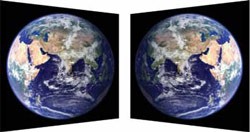Earth's Twin

By Joe Giacobello
Do alien beings exist in some distant corner of the galaxy? Astronomers believe that, if they do, they are probably living on a planet much like our own. In an effort to seek out and find such planets, NASA launched the Kepler spacecraft in March 2009.
Kepler Mission
The purpose of the Kepler Mission was to discover Earth-like planets that orbit other stars. Its goal was to survey portions of the Milky Way galaxy in search of Earth-sized planets located in or near the habitable zone, and to determine how many of the billions of stars in the galaxy have such planets. Over the last few years, the mission has reported some interesting results. By December 2011, there were over 2,300 planet candidates, several of which were found in the habitable zones of surveyed stars. On December 5, NASA announced the discovery of Kepler-22b -- the first planet officially confirmed to exist in the habitable zone.
Earth's New Twin
The new planet, located in a galaxy about 600 light years away, bears many similarities to Earth. Rotating around a star that is very similar to the sun, Keppler-22b is relatively close in size to Earth (about 2.4 times larger). With an orbit of 290 days, its year is almost the same length as the Earth's 365 days. A near "solar twin" to the Earth, it is surmised that the light hitting the planet's surface is likely the same color as that which illuminates our planet. Most importantly, it is situated at a distance from its sun where liquid water could very well exist. The average temperature of the planet's surface is estimated to be in the comfortable 70 degree range.
The Mystery Remains
Whether or not there is life on the new planet has yet to be determined. An organization called SETI (Search for Extraterrestrial Intelligence) in northern California is now focusing its 42-dish Allen Telescope Array at the planet, in hopes of finding some sign of communication. A preliminary search for radio signals from Kepler-22b is under way. Unfortunately, we won't be able to actually travel to our "twin planet" any time soon, as it is estimated that it would take our current space shuttle about 23 million years to get there.
Classroom Discussion
- Do you believe that life exists on other planets in the universe? Why?
- How have modern books and movies portrayed the idea of extraterrestrial beings? Have they painted them in a positive or negative light? Give examples.